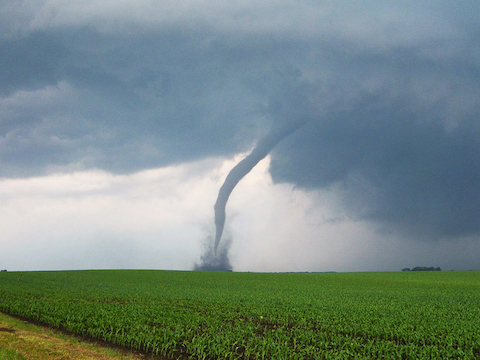
Tornadoes are mysterious. But on this EarthDate, we’ll try to unravel a few of their secrets.
You’ve probably heard there’s a “tornado season” that happens in “tornado alley.” Well, not exactly.
Tornadoes can happen almost anywhere—North and South America, Australia and New Zealand, South Africa, and the Indian subcontinent, where they’re most deadly due to higher population density.
And they can happen any time. Most occur within a few months…but that depends on where you are. In the southeastern US, it’s January through March. In the central plains, April through June. In the Midwest, July through September. The only months they’re less frequent are October through December.
Tornadoes appear to form from the cloud downward. But that’s not really the case. Researchers think most of them form horizontally, within the cloud, like a rolling barrel. Then an updraft turns them vertical, and they extend to the ground…
Or not. Some scientists think they may form from the bottom up, as a swirling wind eddy on the ground reaches up to the cloud, connecting to and triggering that rolling barrel of wind. Or it could be some of each.
But we can’t really tell by looking at radar since tornadoes form too quickly and too near the ground for our current technology to map them.
Clearly, there’s still a lot of mystery surrounding tornadoes. But as research comes in, we’ll keep blowing it your way.
Background
Synopsis: Tornadoes are one of Earth’s most violent and unpredictable atmospheric phenomena. Also called cyclones and twisters, they may produce wind gusts in the funnel exceeding 300 mph (480 km/h) with the capability of picking up large objects and dropping them miles away, as well as leveling structures along their path. Tornadoes are particularly dangerous because they are difficult to observe and predict—most last less than 10 minutes. Given the right storm conditions they form very quickly at the lower limits of radar coverage from dynamic atmospheric triggers below the resolution of many meteorological tools. Researchers are still trying to work out basic questions, including whether they propagate from the top down or bottom up and what causes them to die.
- Tornadoes are rotating columns of air that extend to the ground from large cumulonimbus thunderclouds.
- During thunderstorms, winds from different directions or with different speeds create wind shear that produces spinning air currents in the clouds.
- This may occur from the action of warm humid air rising while cool air and precipitation fall past it, or as a result of variable winds at different altitudes.
- These spinning currents usually start out horizontal, but storm updrafts may turn them vertical, enabling them to drop down from a supercell thundercloud as a tornado.
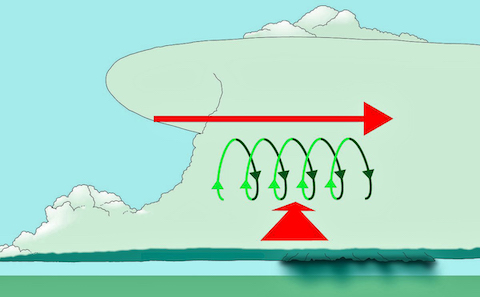
Wind shear (red arrows) caused by winds from differing directions causes a mass of air to begin spinning horizontally. Credit: Vanessa Ezekowitz, CC BY-SA 3.0 <http://creativecommons.org/licenses/by-sa/3.0/>, via Wikimedia Commons 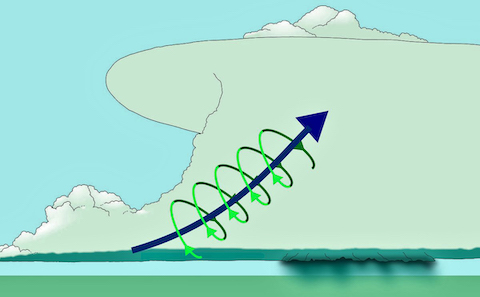
Thunderstorm updrafts push the spinning air upright, forming the vertical axis of the supercell storm. Credit: Vanessa Ezekowitz, CC BY-SA 3.0 <http://creativecommons.org/licenses/by-sa/3.0/>, via Wikimedia Commons - Supercell storms that produce tornadoes typically produce hail and heavy rain with frequent lightning as well as strong nontornadic winds.
- Tornadoes are invisible.
- When we see a tornado dropping from a storm cloud, what we are actually seeing is the condensation funnel caused as water droplets condense in response to the pressure drop that occurs within the invisible vortex of wind that surrounds the visible funnel.
- If the condensation funnel makes contact with the ground the phenomenon is called a tornado; otherwise, it is referred to as a funnel cloud.
- When we see a tornado touch down on the ground, we usually also see swirling debris that has been entrained in the churning winds.
- Most tornadoes create about 250 ft (80 m) wide destructive paths for a few miles (several km) along the ground with wind speeds around 110 mph (180 km/h), but they can grow much larger.
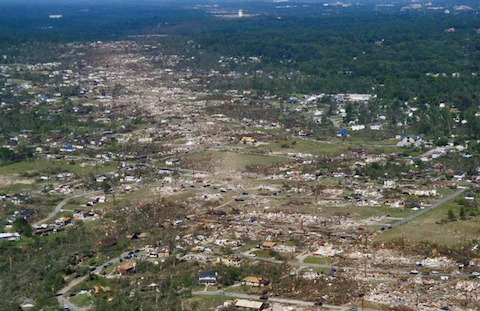
On April 27, 2011, a long-track tornado cut a destructive swath through Alabama, striking Tuscaloosa and Birmingham before lifting off the ground. New research suggests that, on average, tornado paths have become longer by about 80 mi (130 km) since 1994. Credit: National Weather Service - The 2013 El Reno, OK Tornado lasted 40 minutes and had the largest diameter ever recorded at 2.6 miles (4.2 km) with winds clocked at 302 mph (486 km/h)— the highest observed wind speeds on Earth. It missed densely populated areas.
- The 1925 Tri-State (MO-IL-IN) tornado left a path that was 219 mi (352 km) long over 7 hours. Modern meteorologists suggest the destruction may have been caused by a family of tornadoes over that great distance.
- Tornado paths tend to follow the track of the larger storm but often wander unpredictably within those tracks.
- Most of Earth’s tornadoes occur in the central and southeastern United States in an area called Tornado Alley.
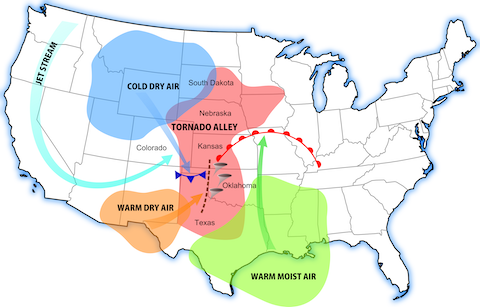
A diagram of the location of Tornado Alley and the related weather systems. Credit: Dan Craggs, CC BY-SA 3.0 <https://creativecommons.org/licenses/by-sa/3.0>, via Wikimedia Commons - North America extends from the tropics to the arctic with no east–west mountain range to block air flow between these extremes.
- Downslope winds from the Rocky Mountains collide with humid air from the Gulf of Mexico generating frequent storms, many of which produce tornadoes.
- Tornadoes have occurred in all 50 states but are rare in Alaska and Hawaii.
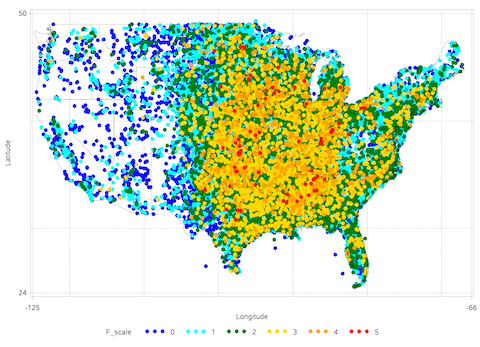
All tornadoes in the continental US, 1950–2013, plotted by midpoint, highest F-scale in warmer colors. Data from NOAA Storm Prediction Center. Credit: Tertius51, CC BY-SA 4.0 <https://creativecommons.org/licenses/by-sa/4.0>, via Wikimedia Commons - More than 1,200 tornadoes occur each year in the United States, killing an average of 60 people per year.
- Tornadoes also occur in Australia, New Zealand, South America (especially Argentina), South Africa, and the Indian subcontinent where the largest number of deaths occur annually. On average, 179 people are killed by tornadoes each year in Bangladesh because of its high population density.
- Tornadoes may occur any time of year but are most common when the atmosphere is more unstable.
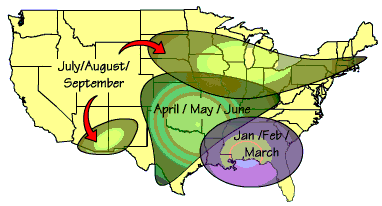
Tornadoes are more common in certain parts of the United States during different seasons, but as climate changes, these regions may be shifting. Credit: Passport to Knowledge - Highest tornado risk in the United States migrates from the southeastern states from January through March, to the Central Plains from April through June, and to the Midwest from July through September.
- Solar heating favors tornado formation so most occur between 3–9 p.m., but damaging tornadoes can occur any time of day or night.
- Tornadoes are compared to each other based on the amount of damage they do because direct reliable measurement of wind speed inside a tornado is difficult.
- The Enhanced Fujita Scale is used in many countries to describe tornadoes.
- EF0 tornadoes damage trees but leave substantial structures intact, while EF5 tornadoes blow away buildings.
- Compared to other weather phenomena, tornadoes are very difficult to observe and predict.
- Tornadoes can form in a matter of minutes and most last for less than 10 minutes, so they are very difficult for researchers to witness.
- Approaching a tornado is risky, and storm trackers must avoid being in their path.
- Tornadoes form within a few hundred feet of the ground surface where it is difficult to scan them in detail with radar due to the interference of trees and buildings.
- Meteorologists know what conditions favor tornado formation so can warn about them with a Tornado Watch. It is not clear when these conditions will generate a tornado and when they will simply diminish, resulting in many false alarms.
- A Tornado Warning is issued if a tornado has been spotted visually on the ground or indicated on radar, but average evacuation warning time is only about 10 minutes, barely enough to get out of a building. It’s better than no alarm, but what would you grab with such short warning? Act immediately!
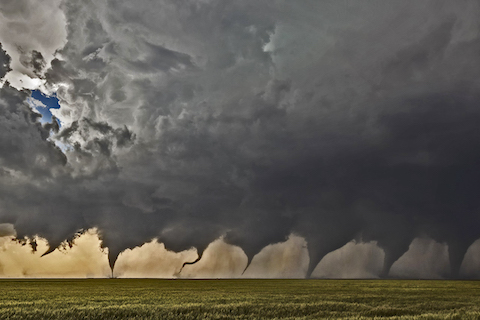
Photomontage of the evolution of a tornado: Composite of eight images shot in two sequences as a tornado formed north of Minneola, Kansas on May 24, 2016. Credit: JasonWeingart, CC BY-SA 4.0 <https://creativecommons.org/licenses/by-sa/4.0>, via Wikimedia Commons
- A Tornado Warning is issued if a tornado has been spotted visually on the ground or indicated on radar, but average evacuation warning time is only about 10 minutes, barely enough to get out of a building. It’s better than no alarm, but what would you grab with such short warning? Act immediately!
- Most radar systems in the United States were developed in the 1980s and use mechanical components that require start-up time to get spinning so don’t provide instantaneous results. New technology is helping to improve accuracy and lead time.
- Modern systems like pulse-Doppler radar use continuous and phased array components that produce detailed real-time data that may help future scientists to better understand the local dynamic atmospheric changes that spawn tornadoes.
- Meteorologists are also testing artificial intelligence to help with picking out patterns in radar data that are too intricate for humans to spot.
- The actual triggers for tornadoes are so difficult to discern that researchers are still trying to understand how tornadoes form.
- Historically, the descent of the condensation funnel caused scientists to hypothesize that tornadoes form from the top down based on data received at 5-minute intervals.
- However, recent high-resolution data collected every 16 seconds by rapid-scanning Doppler radar showed that for four different systems, the invisible twirling winds of the tornado initiated closer to the ground or at multiple levels before weather radar saw the rotation.
- For the 2013 El Reno, OK system, the vortex was photographed 60 ft (20 m) above the ground. Then just minutes later rotation reached up to 11,500 ft (3,500 m), a palpable illustration of the unpredictable ferocity of these storms.
- Some researchers think storms may form from the top down, or from the bottom up, or from both directions simultaneously. More research is needed.
- Another unanswered question for more study is “What makes tornadoes die?”
- Once the air gets cold enough, the inflow of new air to the storm is cut off, but beyond that, we just don’t know.

